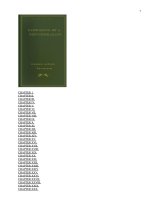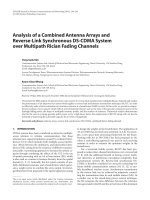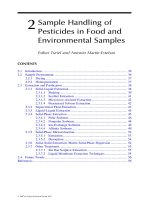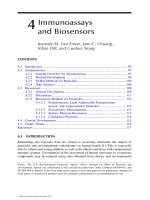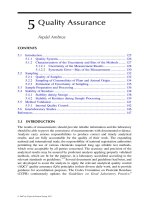Exergoeconomic analysis of a combined water and power plant 3
Bạn đang xem bản rút gọn của tài liệu. Xem và tải ngay bản đầy đủ của tài liệu tại đây (3.43 MB, 34 trang )
Experiments
___________________________________________________________________________
97
CHAPTER 4
EXPERIMENTS
In this chapter, the single-effect desalination system and the reverse osmosis system
used for experiments in the present study are described. Different components of the
system together with their designed specifications have been elaborated. The
methodologies adopted during experimental studies are also introduced here. The
operating conditions have been selected as close to real scale operation of a Multi-
effect Desalination (MED) and Reverse Osmosis (RO) unit. Efficient design of the
evaporator plays a key role in the thermal performance of a MED system. A single
tube vertical desalination evaporator has been used to study the characteristics in a
greater detail. In this experimental study, 12 different kinds of tube profiles have been
considered for the design of the evaporator. Copper-Nickel (90-10) and Aluminum
have been chosen as the materials for the design of evaporators.
4.1 The Desalination Unit
A Single-effect desalination system was designed and fabricated in the Thermal
Process Lab 1 at National University of Singapore. The system utilizes waste heat in
the form of hot water (45-70
0
C) as the heating source instead of steam. A schematic
diagram of the system is shown in Figure 4.1. A photograph of the system is shown in
Figure 4.2.The key components of the desalination system are the shell and tube type
two-phase heat exchanger/evaporator, feed water tank, hot water tank, vacuum pump,
blow down pump and chilled water tank. Saltwater with variable concentrations
(15,000-35,000 ppm) was used as feed in the feed water tank for experimental studies.
Experiments
___________________________________________________________________________
98
The evaporator is provided with a recirculation system for returning the blow down
saltwater back to the feed tank.
Figure 4.1 Schematic diagram of the desalination system
4.1.1 Operation of the desalination unit
The desalination unit is operated under different conditions. Experiments were carried
out by using both real and simulated seawater (salt mixed with water at variable
concentrations) (15,000-35,000 ppm) was used as feed. The results obtained did not
differ significantly. The feed tank with a capacity of 600 litres contains the salt water.
A water level indicator (refer to Figure 4.2) is attached to the feed tank. The feed tank
is connected to the evaporator through copper pipes, valves, and fittings. A flow meter
indicates the volume flow rate of feed water to the evaporator. The feed tank has a
Experiments
___________________________________________________________________________
99
heating element of 15 kW to control the temperature of the feed water entering the
evaporator.
The feed pump circulates the feed water to the evaporator. Feed water flows through
the tubes from the bottom of the evaporator. The heating medium tank contains hot
water as the heating fluid in the shell-side of the evaporator. It has a capacity of 100
litres with a heating capacity of 24 kW. The temperature range for the hot water is 45-
65
0
C.
In the desalination rig, hot water enters the shell-side at the top, left at the bottom and
returned to the hot water tank for recirculation after heating. Feed water flows through
tubes entering from the bottom of the evaporator. The flow arrangement is counter-
current inside the evaporator. The hot water flow rate can be controlled by means of a
ball valve. In the evaporator, an average vacuum pressure of 80 mbar is maintained
with the help of a liquid ring vacuum pump. The feed saltwater reaches the saturation
temperature corresponding to the evaporator pressure by absorbing heat from the hot
water.
The generated vapour from the evaporator is taken away by the vacuum pump. The
level of feed saltwater inside the evaporator can be monitored through the sight glass
attached to it. As it is difficult and not desirable for 100% recovery of freshwater from
seawater due to an increasing level of concentration and scaling problems, part of the
feed saltwater which is not evaporated is either returned to the feed tank or purged to
the drain by means of a blow down pump.
A continuous flow of chilled water is maintained inside the vacuum pump. The
vapour is condensed by directly mixing with the chilled water and returned to the
chilled water tank. The water is then recirculated to the vacuum pump at a
Experiments
___________________________________________________________________________
100
temperature less than 15
0
C. The vapour production is measured from the difference of
feed flow rate and rejected brine flow rate using a flow totalizer. The level difference
in the feed water tank in a continuous steady state operation also indicates the vapour
production when rejected brine solution is returned to the feed tank.
Concentrations (ppm) of the feed brine solution, product fresh water and rejected
brine solutions are measured by a conductivity meter which indicates the salinity. The
operation of the desalination plant is controlled by a control panel installed in the rig.
All the pumps and motors are provided with on-off control. The temperatures of the
feed tank and heating medium tank are controlled by temperature controllers.
4.1.2 Specifications of the components
Table 4.1 Components Specifications
1. Evaporator
a. Shell and Tube Shell and Tube type Evaporator
Total number of tubes: 175
b. Tube Material &
Geometries.
I. Single-fluted Aluminum.
II. Smooth Copper-Nickel.
III. Corrugated Copper-Nickel.
IV. PTFE coated Aluminium tube
c. Shell Material Carbon Steel with 9.5 thickness.
d. Insulation Rock wool insulation
Thickness: 25 mm
2. Heating Medium
Tanks
a. Material Carbon steel Thickness: 2.5 mm.
b. Capacity 100 litre
c. Insulation Rockwell insulation with aluminum
jacket.
Thickness: 50 mm
3. Feed Tank
a. Material Carbon Steel.
Thickness: 2 mm
b. Capacity 600 litre
c. Insulation Rockwell insulation with aluminum
jacket.
Thickness: 50 mm
4.Liquid ring
Vacuum Pump
a. Rotor Star type rotor made of bronze
b. Capacity
250 m
3
/hr at 80 mbar
Experiments
___________________________________________________________________________
101
4.2 Design of the components
In designing the desalination system, the careful selection and sizing of the
components were made for smooth running of the system. A photograph of the system
is shown in Figure 4.2.
Figure 4.2 A Photograph of the desalination Rig
Details of different components of the system and their design considerations are discussed in
the following section.
4.2.1 Evaporator
The design of the evaporator is crucial for any thermal desalination process. Efficient
design of the evaporator can considerably enhance the thermal performance of a
desalination system. The evaporator used in the single-effect desalination system for
experimental study is basically a shell and tube two-phase heat exchanger. Hot water
is allowed to flow through the shell side of the evaporator from the top. There is a
baffle in the middle of the evaporator to enhance the heat transfer performance in the
Experiments
___________________________________________________________________________
102
shell-side. The evaporator mainly consists of three parts: the top cover, shell with the
tube-bundles
and bottom cover. There is a sight glass in the top cover of the
evaporator for visual observation of the water level in the evaporator. The evaporator
is shown in Figure 4.3.
Figure 4.3 A Photograph of the Evaporator
In total, there are 175 tubes inside the tube bundle. Inside diameter of the shell is 400
mm with a thickness of 9.5 mm. The tube layout in the bundle is shown in Figure 4.4.
Figure 4.4 The layout of tubes inside the evaporator
Experiments
___________________________________________________________________________
103
The shell construction material is Carbon steel having a length of 500 mm. The tube
arrangement in the tube-bundle is of triangular pitch having a pitch of 25.5 mm in
equilateral triangle. The clearance between the tubes is 6.5 mm.
Four different kinds of tube profiles have been considered for the evaporator design in
this research work. These are:
a. Aluminum Brass Tube.
b. Smooth Cu-Ni (90-10) Tube.
c. Corrugated Cu-Ni (90-10) Tube.
d. PTFE Coated smooth Aluminium Tube.
Each of the tube profiles has been discussed here.
4.2.1.1 Single-fluted Aluminum Tube
As the fluted surface exhibits higher heat transfer performance when used in the
evaporator of a thermal desalination system, single-fluted Aluminum tube profile has
been considered for this study. As there were several past investigations on the
double-fluted tube documented in the available literature, the aim here is to
investigate the thermal performance of the evaporator using tube profile with fluted
outside surface.
Aluminum is considered here as tube material for its superior thermal conductivity
and popularity in desalination industries from an economic point of view. The inside
and outside diameter of the tube are 13 mm and 19 mm, respectively. The thickness of
the tube is 3.25 mm and the length is 500 mm. The tubes are joined with shell and
using grommet joint at the bottom and top cover of the shell. The maximum
permissible pressure for this tube bundle is 4 bar. Figure 4.5 shows the cross section
of fluted tube profile.
Experiments
___________________________________________________________________________
104
4.2.1.2 Smooth Copper-Nickel (90-10) Tube Profile
Smooth Copper-Nickel (90-10) tube profile has been considered for the second tube-
bundle of the evaporator in this study. The advantage of Copper-Nickel (90-10) lies in
its superior thermal conductivity and can be fabricated thin compared to other tube-
profiles.
To be used preferably in marine conditions, as it forms a protective film which is
multi-layered in flowing seawater. It can resist marine bifouling.
The tube thickness
considered for this study is 1.65 mm. The inside and outside diameters of the tube are
13 mm and 16.2 mm, respectively. The tubes are connected to the shell by the
expansion and O-ring.
4.2.1.3 Corrugated Copper-Nickel (90-10) Tube Profile
Corrugated copper-nickel (90-10) material was used for the third tube-bundle. The
thermal performance of the evaporator with corrugated Cu-Ni tube profile has been
compared with that of smooth profile. The corrugated tube-bundle is shown in Figure
4.5.
Figure 4.5 Corrugated Cu-Ni (90-10) Tube-bundle
The details of the geometry of the corrugated tubes are shown in Table 4.2
Table 4.2 Specification of Corrugated Cu-Ni (90-10) tube profile
Helix angle 69.8 degree
Pitch 7.25 mm
Groove width 2.25 mm
Experiments
___________________________________________________________________________
105
4.2.1.4 PTFE-Coated Smooth Aluminum Tube Profile
Scaling is considered to be the most serious problem in the operation of a desalination
unit. Several research investigations have been made to minimize scaling (Aly et al.,
2003, El-Dessouky and Ettouney, 2002,
Kalender and Griffiths, 2001). Poly Teflon
coated Aluminum tube was used to find performance in reducing scaling. The aim is
to investigate the thermal performance of the coated tube-bundle and scaling potential
on the inside surface of the tube. As coating inside tube surface is very difficult, the
thickness of the coating is maintained thin (75 micron) for better adhesiveness and
bonding strength. The specifications of the PTFE coating are outlined in Table 4.3.
Table 4.3 Technical Specification of PTFE Coating
Chemical Compound XYLAN 1400 RC/437 Green
Thickness ~75 micron
Dry film thickness 0.7-0.9 mm
Pencil hardness 4-6 H
Adhesion
1.0 mm cross hatch and place in boiling water 15 minutes;
after 5 tape pulls = no effect
Cure test 50 + Firm rubs with MEK soaked cloth = no effect
Thermal resilience
180
0
C (Continuous)
240
0
C (Intermittent)
Ref: Technical bulletin of Whitford Pte. Ltd.
Tube Thickness 1.65 mm
Inside diameter 13 mm
Outside diameter 16.2 mm
Experiments
___________________________________________________________________________
106
4.2.2 Feed Water tank
The system contains a feed tank of 600 litres capacity to store the feed water. The
feed tank is shown in Figure 4.6. The tank is cylindrical type with a height of 1.5 m
and inside diameter of 0.7 m. The tank is made of stainless steel (SS 316) with a wall
thickness of 2 mm. A level gauge is attached with the tank to observe the water level
in the tank. The tank is insulated with rockwool covered by an aluminum jacket.
Three heaters each with a capacity of 5 kW are included inside the tank for preheating
the feed water. The temperature inside the tank is controlled by a temperature
controller with a solid-state relay. A RTD sensor is used to measure the temperature
of the water.
Figure 4.6: Schematic diagram of the feed water tank
4.2.3 Heating Medium Tank
Hot water is considered as the heating medium for the desalination system instead of
steam. The idea is to implement the waste heat utilization concept which may be in
Vent with
valve
Heater
0.7 m
Insulation
1.5 m
Cover
socket
Experiments
___________________________________________________________________________
107
the form of low pressure steam taken either from the waste heat recovery boiler or
bled steam. The tank capacity is 100 litres with a height of 660 mm. Construction
material of the tank is cast iron with a thickness of 2mm. The tank is insulated by 50
mm Rockwell insulation with aluminum jacket to prevent heat loss. The tank includes
2 heaters of 24 kW capacities to heat the recirculating water in a temperature range of
45-65
0
C. Temperature of tank is controlled by a temperature controller with a solid-
state relay. The function of controller is to maintain the temperature of the tank at the
desired temperature. A RTD sensor is used to measure the temperature of the tank.
The schematic diagram of the tank is shown in Figure 4.7.
Figure 4.7 Schematic diagram of the heating medium tank
4.2.4 Vacuum pump
The evaporator pressure is maintained in a range of 80-100 mbar by a liquid ring
vacuum pump. The capacity of the vacuum pump is 250 m
3
/hr at 80 mbar. A star
type rotor rotates inside the pump and there is a continuous supply of chiller water for
efficient operation. Figure 4.8 shows the photograph of the vacuum pump.
Heate
0.455 m
Insulation
Vent with
valve
Socket
point
660 mm
Cover
Socket
point
Experiments
___________________________________________________________________________
108
Figure 4.8 A photograph of the Vacuum pump
4.2.5 Blowdown pump
A specially designed blowdown pump is used in the system for recirculation of the
rejected brine from the evaporator. The blowdown pump is of low NPSH (net positive
suction head) as it has to work against negative pressure in its inlet. The NPSH of this
centrifugal blowdown pump is 0.5 and its impeller is made of stainless steel, as it has
to deal with brine solution. Figure 4.9 shows the blow down pump.
Figure 4.9 A photograph of the Blowdown pump
Experiments
___________________________________________________________________________
109
4.3 Test procedure
A series of experiments were conducted in order to investigate the thermal
performance of the system under different operating conditions. During each
experiment the following procedure was carried out.
• The feed tank was first filled with supply water and the level was checked by
level gauge. As there was difficulty in accessing the actual pretreated
seawater, the feed water was mixed with desired amount of salts for a fixed
concentration in order to simulate the seawater. The mixing was done by the
feed pump in recirculation/by pass flow to the tank. The concentration of the
feed brine solution was checked by a conductivity meter.
• A definite amount of Ameroyal (Anti-scaling agent, 25 ml/m
3
) was mixed
with the feed water to prevent excessive foam formation inside the evaporator.
• The feed temperature was checked and the feed water was heated by the heater
on the set temperature of a given operation in the system.
• Hot water tank was checked and filled up with water.
• The heater of the hot water tank was switched on to set the temperature at
desired condition.
• The vacuum pump was started and continued to run until the pressure was set
to the minimum value. The chill water pump was started to circulate chilled
water from the chiller water tank to the vacuum pump.
• Feed water and hot water pump were started at desired flow rates in
continuous manner.
• After starting the blowdown pump, a particular flow rate was fixed by
adjusting the valve at the by pass line.
Experiments
___________________________________________________________________________
110
• Steady state condition was attempted for each experimental run by observing
the different operating variable of the system. Once the steady state was
obtained, different measurement values were noted.
• The pressure inside the evaporator was maintained fixed by controlling the
vacuum pump flow rate.
• The data were taken for each 15 minutes of operation.
• The concentrations of the rejected brine and product water were monitored by
the conductivity meter.
The changes of the operating variables during the experimental investigations are
listed in Table 4.4.
Table 4.4 Operating variables and their ranges during the experiment
Operating variables Ranges
Feed water flow rate
(m
3
/hr)
0.21~1.0
Heating medium flow rate (m
3
/hr)
1.5~3.5
Feed water temperature (
0
C)
30~50
Heating medium temperature (
0
C) 47-65
Chamber pressure (mbar) 60~130
Concentrations (ppm) 15,000; 25,000; 30,000 and 35,000
4.4 Vertical Single tube heat exchanger
Multi effect desalination consists of a number of evaporators/effects. These effects
individually make up the performance of the whole MED system. So, a single tube
heat exchanger experimental set up was used to study different tube profile (with or
without inserts) to find the heat transfer enhancement characteristics in detail and
improve the performance of the MED system. The objective of using this set up was
to get deeper understanding of the heat transfer mechanism inside a tube under the
same conditions as it would undergo in a desalination effect. It should be noted that,
this fabricated system is able to take into account all the possible complexities
encountered in a fully functional multi-effect desalination unit. This experimental
Experiments
___________________________________________________________________________
111
setup provides a good platform to examine the heat transfer capabilities of single tube
evaporators with permutations (refer to Figure 4.24) in material, different
augmentation techniques as well as other experimental variables. The detailed
technical specification and its characteristics are described in the following sections.
4.4.1 Experimental Setup
A lab scale single tube vertical heat exchanger was designed and fabricated, as shown
in Figure 4.10 in the thermal process lab of National university of Singapore to
investigate the effect of pitch and depth on heat transfer characteristics. The single
evaporator tube experiment was set up in the thermal process laboratory after coming
up with its modular design, fabrication and testing. All of the components used, were
either fabricated locally or obtained directly from the laboratory, except for the
evaporator tubes.
4.4.1.1 Evaporator Tubes
Four different types of materials were used for the evaporator tubes, namely Stainless
Steel, Aluminum-Brass, Copper-Nickel and Copper. However, the copper evaporator
tube exhibited too much of corrosion effects despite running only a few sets of
experiments (total run time of about 3 hours). Even though copper is a good
conductor of heat with a thermal conductivity of 401W·m
−1
·K
−1
(second only to
silver), it would not be economically feasible to be replacing the tube so often due to
corrosion. Hence, in choosing the best material, the life cycle of the evaporator tube
also has to be given consideration and thus, despite copper having the best
Experiments
___________________________________________________________________________
112
conductivity, the results obtained for copper is not used for analysis here. All the
evaporator tubes come with the exact dimensions given below.
Figure 4.10 Schematic of the single tube experimental setup.
The Figure below shows four different heat exchanger tube materials to be tested:
Figure 4.11: Picture of the four evaporator tubes used
In the desalination industry today, different materials are used for evaporators. The
common materials used and their respective pros and cons are given in Table 4.4.
Feed water
bath
Valve
Temperature
sensor
Flow meter
Pressure gauge
Vacuum
pump
Single tube heat exchanger
Hot water
bath
Experiments
___________________________________________________________________________
113
Table 4.5 Common Materials used as MED evaporator tubes in Desalination industry
Material Comments
Copper and its constituent alloys
Best performance index, but relatively
poor corrosion resistance
Brasses (Alloy of copper and zinc)
Slightly better resistance to corrosion but
lower thermal conductivity
Stainless Steel
High corrosion resistance and industrial
life (up to 40 years) but lower
conductivity compared to other materials
Aluminum Bronzes
Lower cost and better conductivity than
steel tubes
Nickel iron aluminum bronze Highly resistant to corrosion but costly
4.4.1.2 Evaporator Tubes profiles
In total, twelve evaporator tubes were fabricated locally for this project. Among the
twelve tubes are four smooth tubes of four different materials namely: Copper Nickel,
Aluminum Brass, Stainless Steel and Copper. The remaining eight tubes are
corrugated profile Aluminum Brass tubes with varying corrugation pitch and depth.
Figure 4.12 illustrates the dimensions for the corrugated tubes. Table 4.5 summarises
the specifications of the twelve evaporator tubes. Figures 4.13, 4.14 and 4.15 depict
both the smooth and corrugated tubes.
Experiments
___________________________________________________________________________
114
Figure 4.12 Corrugated tube dimensions: Corrugation pitch p and corrugation depth h.
Figure 4.13 Four smooth evaporator tubes of different materials: Copper Nickel,
Aluminum Brass Stainless Steel and Copper.
Table 4.6 Specifications of the twelve evaporator tubes
Material Type
Length
(mm)
Inner
Diameter
(mm)
Corrugation
Pitch p (mm)
Corrugation
Depth e (mm)
Copper
Nickel
Smooth
1110 15
- -
Aluminum
Brass
- -
Stainless
Steel
- -
Copper
-
-
Aluminum
Brass
Corrugated
Profile
10
0.3
10
0.5
15
0.3
15 0.5
20 0.3
20 0.5
Experiments
___________________________________________________________________________
115
25 0.3
25 0.5
Figure 4.14 Two evaporator tubes of different corrugation depths: (Top) Corrugation
depth 0.2mm, (Bottom) corrugation depth 0.6mm.
Figure 4.15 Three evaporator tubes of different corrugation pitch: (Top) Corrugation
pitch 10mm, (Centre) corrugation pitch 15mm, (Bottom) corrugation pitch 25mm.
Experiments
___________________________________________________________________________
116
4.4.1.3 Wire Coil Insertions
The wire coil insertions used in this experiment for heat augmentation purposes are
basically springs made from stainless steel grade 316. Unlike the copper zinc
insertions used initially, these stainless steel insertions do not have a central
cylindrical rod. This drastically reduces the pressure drop experienced by feed water
flowing through the evaporator tubes and improves energy efficiency. In addition,
these insertions closely resemble those featured in earlier literatures. Figure 4.16
shows both insertions used in the experiment.
Figure 4.16 A photograph of the insertions used in the experiment
4.4.1.4 Hot and Feed Water Baths
Both the hot and feed water baths are of the same model and functions to maintain
water temperatures at specific desired values. The feed water bath provides a constant
supply of feed water into the evaporator tube for flashing while the hot water bath
plays the role of a heater for the incoming feed water. The water baths have a capacity
of 10 litres and can supply a maximum pumping power of 25KW. Variables such as
the heat medium temperature and feed temperature are altered using the hot water
bath and feed water bath, respectively. Thick nylon hoses serve as connection
Experiments
___________________________________________________________________________
117
between the inlets and outlets of the water baths and the copper pipes. Figure 4.17
below shows the water bath used for this experiment.
Figure 4.17 Hot water bath
4.4.1.5 Tube Shell Setup
Figure 4.18 3D view of shell tube heat exchanger .
Experiments
___________________________________________________________________________
118
The most critical component in the entire experiment would be the tube shell setup as
it is where heat exchange occurs between the hot water and feed water. The heat
energy imparted from the hot water allows for flashing of the feed water to manifest.
Figure 4.18 shows a 3D graphical representation of the tube shell setup.
As observed from Figure 4.19, the hot water from the hot water bath enters from the
top, down the annulus and exits the shell side at the bottom. Feed water is introduced
from the bottom and it flows through the evaporator tube mounted in the centre,
making this a counter-flow configuration.
Figure 4.19 Flow pattern within the shell tube heat exchanger with insert
(Longitudinal view).
4.4.1.6 Measuring Instruments
The remaining components of the experimental setup include
• Resistance temperature detectors (RTDs) attached to a data logger shown in
Figure 4.20,
• Flow meters (refer to Figure 4.21),
• Vacuum pump (refer to Figure no. 4.22),
Hot water
Feed water
Experiments
___________________________________________________________________________
119
The RTDs basically measure the temperatures at the inlet and outlet of the tube
shell setup. The flow meters are used for the monitoring of the water flow rates
from the hot and feed water baths. The function of the vacuum pump is to
maintain the pressure at approximately 50°C saturation pressure (12kPa). The
heating medium and feed flow rate will be regulated with the use of ball valves.
Lastly, the copper pipes and nylon hoses links the components together. The
following Figure 4.23 provides a graphical representation of the various
components as well as the entire experimental setup.
Figure 4.20 RTDs are connected to this data logger where temperatures are recorded.
Experiments
___________________________________________________________________________
120
Figure 4.21 Flow meters which are used to regulate the heating medium and feed flow
rates.
Figure 4.22 Vacuum pump.
Experiments
___________________________________________________________________________
121
Figure 4.23 Photograph of the experimental set up
4.4.1.7 Experimental Procedure
Before commencement of the experimental run, the various apparatus and equipment
would have to be checked and adjusted to the desired conditions. In the following
sections a brief overview of the entire experimental procedure is presented:
[1] Both the hot and feed water bath would have to be filled to their maximum
capacity. They are then switched on and calibrated to the desired values. The
regulators on both water baths are in the ‘closed’ position.


